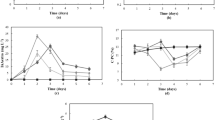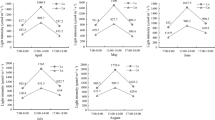Summary
We investigated the influence of light intensity and pH on growth and acetylene reduction in three strains of Azolla filiculoides and one strain of A. pinnata cultivated under ambient conditions in Naples, Italy. A. pinnata showed maximum growth and acetylene reduction activity at 65% of natural light intensity (82 Klux) and at pH 5–7. In contrast, three A. filiculoides strains showed maximum values in a wider range of light intensity (50–100%) and pH (5–9). All optimal growth conditions of light intensity and pH were obtained from the determination of doubling time for dry and fresh weight increases. The lowest doubling time for all strains was in the range 2.7–3.3 days. Under these optimal conditions, the acetylene reduction activity rates were 46 nmol ethylene h−1 mg−1 dry weight for two strains of A. filiculoides from California, and 90 nmol for A. filiculoides from Naples and A. pinnata from Tancheng, Peoples Republic of China. These values correspond to those reported for strains of A. filiculoides and A. pinnata cultivated in areas outside Italy where the use of Azolla as biofertilizer has resulted in increased crop production. Therefore, the strains studied here may have a similar potential in Southern Italy as a source of biomass, dry matter and nitrogenous compounds.
Similar content being viewed by others
References
Ashton PJ (1974) The effects of environmental factors on the growth of Azolla filiculoides Lam. In: Zinderen-Bakker EMV (ed) The Orange River Progress Report (Institute for Environmental Sciences). University of the Orange Free State, Bloemfontein, South Africa, pp 123–138
Aziz T, Watanabe I (1983) Influence of nutrients on the growth and mineral composition of Azolla pinnata R. Br. (Bicol, Philippines). Bangladesh J Bot 12:166–170
Bozzini A, De Luca P, Moretti A, Sabato S, Siniscalco Gigliano G (1984) Comparative study of six species of Azolla in connection with their utilization as a green manure for rice. In: Silver WS, Schroder EC (eds) Practical application of Azolla for rice production, Proc Int Workshop, Mayaguez, Puerto Rico, 1982, Martinus Nijhoff, W Junk, Dordrecht Boston Lancaster, pp 125–131
Hardy RWI, Holsten RD, Jackson EK, Burns RC (1968) The acetylene-ethylene assay for N2-fixation: Laboratory and field evaluation. Plant Physiol 43:1185–1207
Holst RW, Yopp JH (1976) Effect of light quantity, osmotic stress, temperature and pH on nitrogen fixation and nitrate reduction by the Azolla-Anabaena symbiosis. Plant Physiol 57:103
Kikuchi M, Watanabe I, Haws LD (1984) Economic evaluation of Azolla use in rice production. In: Int Rice Res Inst, Organic matter and rice. Los Baños, pp 569–592
Kulasooriya SA, Hirimburegama WK, de Silva RSY (1980) Effect of light, temperature and phosphorus on the growth and nitrogen fixation in Azolla pinnata native to Sri Lanka. Oecol Plant 1:355–365
Lumpkin TA, Plucknett DL (eds) (1982) Azolla as a green manure: Use and management in crop production. Westview Tropical Agriculture, Westview Press, Boulder, Colo
Margheri MC, Materassi R, Balloni W, Paoletti C (1979) Coltura massiva di Azolla caroliniana: Prime esperienze in Italia ed importanza agronomica del processo. Agric Ital 108:199–210
Margheri MC, Tomaselli L, Filpi C (1984) Research on the mass culture of Azolla caroliniana and A. filiculoides in Italy. In: Silver WS, Schroder EC (eds) Practical application of Azolla for rice production. Proc Int Workshop, Mayaguez, Puerto Rico, 1982. Martinus Nijhoff, W Junk, Dordrecht Boston Lancaster, pp 212–213
Moore AW (1969) Azolla: Biology and agronomic significance. Bot Rev 35:17–35
Nickell LG (1961) Physiological studies with Azolla under aseptic conditions. Vol II. Nutritional studies and the effects of the chemicals on growth. Phyton (Buenos Aires) 17:49–54
Peters GA, Ray TB, Mayne BC, Toia RE Jr (1980a) Azolla-Anabaena association: Morphological and physiological studies. In: Newton WE, Orme-Johnson WH (eds) Nitrogen fixation. University Park Press, Baltimore, II, pp 293–309
Peters GA, Toia RE Jr, Evans WR, Christ DK, Mayne BC, Poole RE (1980b) Characterization and comparison of five N2-fixing Azolla-Anabaena associations. I Optimization of growth conditions for biomass increase and N content in a controlled environment. Plant Cell Environ 3:261–269
Rains DW, Talley SN (1978) Use of Azolla as a source of nitrogen for temperate zone rice culture. In: Proc Second Rev Meet INPUTS Project, East West Center Resource Systems Institute, Honolulu, Hawaii, USA, pp 167–174
Subudhi BPR, Watanabe I (1981) Differential phosphorus requirements of Azolla species and strains in phosphorus-limited continuous culture. Soil Sci Plant Nutr 27:237–247
Talley SN, Rains DW (1980) Azolla filiculoides Lam. as a fallow-season green manure for rice in a temperate climate. Agron J 72:11–18
Talley SN, Rains DW (1982) Potential mechanization of Azolla cultivation in rice field. In: Lumpkin TA, Plucknett DL (eds) Azolla as a green manure: Use and management in crop production. Westview Tropical Agriculture, Westview Press, Boulder, Colo, pp 141–159
Tung HF, Shen TC (1981) Studies on the Azolla-Anabaena azollae symbiosis: Growth and nitrogen fixation. New Phytol 87:743–749
Tung HF, Watanabe I (1983) Differential response of Azolla-Anabaena associations to high temperature and minus phosphorus treatments. New Phytol 93:423–431
Vincenzini M, Margheri MC, Sili C (1985) Outdoor mass culture of Azolla spp.: Yields and efficiencies of nitrogen fixation. Plant Soil 86:57–67
Watanabe I (1982) Azolla-Anabaena symbiosis: Its physiology and use in tropical agriculture. In: Dommergues YR, Diem HG (eds) Microbiology of tropical soils and plant productivity. Martinus Nijhoff, W Junk, The Hague Boston London, pp 169–185
Watanabe I (1984) Use of symbiotic and free-living blue-green algae in rice culture. Outlook Agric 13:166–172
Watanabe I, Berja NS (1983) The growth of four species of Azolla as affected by temperature. Aquat Bot 15:175–185
Watanabe I, Espinas CR, Berja NS, Alimagno BV (1977) Utilization of the Azolla-Anabaena complex as a nitrogen fertilizer for rice. Int Rice Res Inst (Los Baños), IRRI Res Pap Ser 11:1–15
Watanabe I, Bai Ke-Zhi, Berja NS, Espinas CR, Ito O, Subudhi BPR (1981) The Azolla-Anabaena complex and its use in rice culture. Int Rice Res Inst (Los Baños), IRRI Res Pap Ser v:1–11
Author information
Authors and Affiliations
Additional information
Research work supported by CNR, Italy. Special grant I. P. R. A. Sub-project 1. Paper No. 814
Rights and permissions
About this article
Cite this article
Moretti, A., Siniscalco Gigliano, G. Influence of light and pH on growth and nitrogenase activity on temperate-grown Azolla . Biol Fert Soils 6, 131–136 (1988). https://doi.org/10.1007/BF00257662
Received:
Issue Date:
DOI: https://doi.org/10.1007/BF00257662




